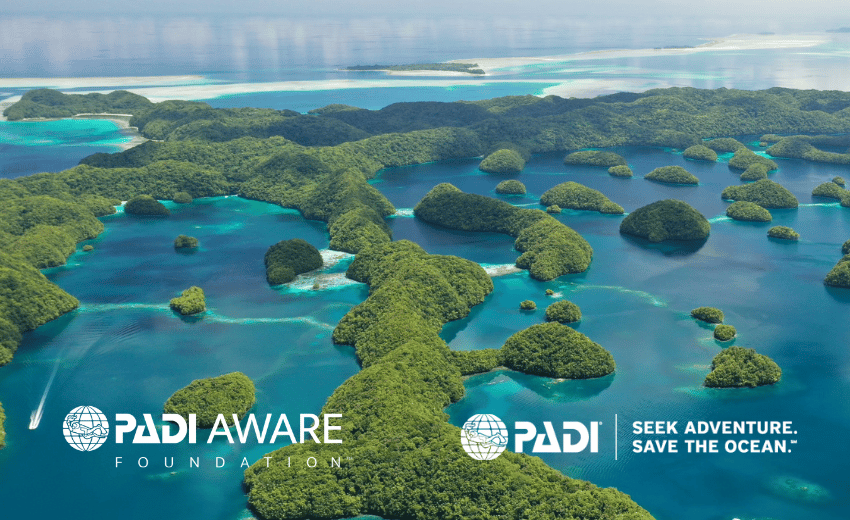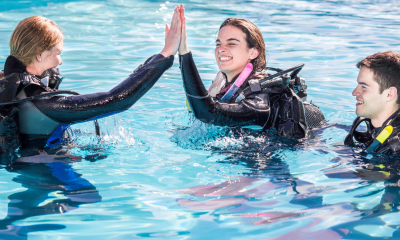Marine Life & Conservation
PADI AWARE’s ‘Adopt the Blue’ Programme to protect 30% of the Ocean by 2030

PADI® and PADI AWARE Foundation have launched an ambitious new initiative to establish the world’s largest network of conservation sites aimed at safeguarding ocean habitats and species threatened with extinction. Managed by the PADI AWARE Foundation™, Adopt The Blue™ will activate a global network of dive sites across the planet to establish more Marine Protected Areas with the support of PADI Members, divers, and ocean torchbearers.
Over the next decade, the Adopt The Blue programme will serve as the connective tissue to drive forward PADI’s Blueprint For Ocean Action, the organisation’s roadmap that underpins all local conservation efforts on marine debris, protection of vulnerable species, restoration of coral reef systems and tackling climate change. These local actions, when replicated and scaled up, will truly help drive global impact.
“Our goal is to create 10,000 Adopt The Blue sites by 2025, working with local communities and PADI operators to accelerate local conservation efforts where they are most needed, and to actively contribute towards protecting 30% of the ocean by 2030,” says Danna Moore, Director of PADI AWARE Foundation.
Since the launch on World Oceans Day this month, 301 sites have been adopted covering a total area of 3159742652m².
Adopt The Blue is supported by PADI MPA Programme founding partner Blancpain, who shares a rich history rooted in the exploration and preservation of the world’s oceans. Together, PADI and Blancpain are committed to establishing the largest inventory of Marine Protected Areas in the world.
PADI’s Mission Hubs are at the heart of Adopt The Blue – the 6,600 dive centres and resorts and more than 128,000 professional members worldwide who will serve as the backbone for the programme’s global footprint, providing unprecedented scale and unmatched potential for participants to take direct action that will drive measurable conservation impact at the local level – all tied to the global commitment to protect 30% of the ocean by 2030.
“Over the years we have been consistently amazed by the passion and readiness of the diving community to take action where and when it’s needed. With the scale and support of our mission hubs, divers and ocean torchbearers will be able to help countries meet their ocean conservation commitments as well as driving forward the creation of coastal MPAs,” continues Moore. “This global collective effort of meaningful action at local levels will help us move the needle on the most urgent conservation issues facing our blue planet.”
The programme does not require Adopt The Blue sites to be diveable, meaning PADI Members can identify any underwater site anywhere in the world that is important to them. These sites could contain an iconic habitat or species, such as mangroves, shallow water seagrass beds, nursery sites, or breeding grounds; even sites that are of particular economic benefit to local communities – as they all contribute to PADI’s overall vision to restore balance between humanity and the ocean. Once the sites are adopted and listed on the Adopt The Blue platform, PADI AWARE Foundation will coordinate the appropriate local, regional and national conservation efforts.
To join the network, visit www.padi.com/aware/AdoptTheBlue/Join.
Blogs
Invitation from The Ocean Cleanup for San Francisco port call

6 years ago, The Ocean Cleanup set sail for the Great Pacific Garbage Patch with one goal: to develop the technology to be able to relegate the patch to the history books. On 6 September 2024, The Ocean Cleanup fleet returns to San Francisco bringing with it System 03 to announce the next phase of the cleanup of the Great Pacific Garbage Patch and to offer you a chance to view our cleanup system up-close and personal.
We look forward to seeing you there.
To confirm your presence, please RSVP to press@theoceancleanup.com
PROGRAM
Join The Ocean Cleanup as our two iconic ships and the extraction System 03 return to San Francisco, 6 years and over 100 extractions after we set sail, to create and validate the technology needed to rid the oceans of plastic.
Our founder and CEO, Boyan Slat, will announce the next steps for the cleanup of the Great Pacific Garbage Patch. Giving you a chance to view our cleanup system and the plastic extracted.
Hear important news on what’s next in the mission of The Ocean Cleanup as it seeks to make its mission of ridding the world’s oceans of plastic an achievable and realistic goal.
Interviews and vessel tours are available on request.
PRACTICALITIES
Date: September 6, 2024
Press conference: 12 pm (noon)
Location: The Exploratorium (Google Maps)
Pier 15 (Embarcadero at Green Street), San Francisco, CA
Parking: Visit The Exploratorium’s website for details.
RSVP: press@theoceancleanup.com
Video & photo material from several viewing spots around the bay
We look forward to seeing you there!
ABOUT THE OCEAN CLEANUP
The Ocean Cleanup is an international non-profit that develops and scales technologies to rid the world’s oceans of plastic. They aim to achieve this goal through a dual strategy: intercepting in rivers to stop the flow and cleaning up what has already accumulated in the ocean. For the latter, The Ocean Cleanup develops and deploys large-scale systems to efficiently concentrate the plastic for periodic removal. This plastic is tracked and traced to certify claims of origin when recycling it into new products. To curb the tide via rivers, The Ocean Cleanup has developed Interceptor™ Solutions to halt and extract riverine plastic before it reaches the ocean. As of June 2024, the non-profit has collected over 12 million kilograms (26.4 million pounds) of plastic from aquatic ecosystems around the world. Founded in 2013 by Boyan Slat, The Ocean Cleanup now employs a broadly multi-disciplined team of approximately 140. The foundation is headquartered in Rotterdam, the Netherlands, and opened its first regional office in Kuala Lumpur, Malaysia, in 2023.
Find out more about The Ocean Cleanup at www.theoceancleanup.com.
Marine Life & Conservation
SHARK MONTH ARRIVES AT ROYAL WILLIAM YARD, PLYMOUTH

A shark has been spotted approaching Royal William Yard in Plymouth, much to the surprise of swimmers, paddleboarders and onlookers.
With its distinctive dorsal fin cutting through the water, the sizeable shark swam along the coastline, before turning to head inland towards Firestone Arch at Royal William Yard. The appearance drew a crowd, who were captivated for more than an hour by the unusual sight – and it was all caught on video.
The shark is one of many expected sightings at Royal William Yard over the coming weeks… because today marks the start of Shark Month!
In reality, the ‘shark’ spotted along the Plymouth shoreline was actually a custom-made model, created by the team at Royal William Yard and sailed underwater by Caroline Robertson‑Brown from the Shark Trust, who donned scuba diving gear for the occasion.
The stunt took place to launch Shark Month in style and draw attention to the work of the leading international conservation charity, which is based in Britain’s Ocean City. Spectators were reassured that the water was safe and many entered into the spirit of the performance, swimming or sailing alongside the shark.
Shark Month will take place across Royal William Yard throughout July and will feature an extravaganza of art, entertainment and advocacy for everyone to enjoy. The packed programme of events starts with an art exhibition and ends with a trip on paddleboards with shark experts – with everything from a shark quiz to a Jaws screening in between.
Paul Cox, CEO of the Shark Trust, said: “There are often assumptions and misconceptions when it comes to sharks. This was certainly the case with the shark spotted at Royal William Yard! While the British coastline is home to many species of shark, this was not one of them. However, we’re thrilled it caught people’s attention, because seeing a shark is a special and memorable moment. That is precisely why we want to celebrate these incredible creatures, highlight the need for conservation, and ask for help to safeguard their future.”
For more information about Shark Month at Royal William Yard, visit the Shark Trust Website.
Images and video: Jay Stone
-

 Blogs2 months ago
Blogs2 months agoDiving With… Nico, Ocean Earth Travels, Indonesia
-

 News1 month ago
News1 month agoMurex Bangka Announce New Oceanfront Cottages & Beachfront Dining
-

 Blogs2 months ago
Blogs2 months agoA new idea in freediving from RAID
-

 Marine Life & Conservation1 month ago
Marine Life & Conservation1 month agoIceland issue millionaire whale hunter a licence to murder 128 vulnerable fin whales
-

 Marine Life & Conservation2 months ago
Marine Life & Conservation2 months agoThe Shark Trust Great Shark Snapshot is back
-

 News3 months ago
News3 months agoCharting New Waters; NovoScuba Goes Global with the Launch of their Revolutionary Dive Training Agency!
-

 Gear News1 month ago
Gear News1 month agoNew Suunto Ocean – a dive computer and GPS sports watch in one for adventures below and above the surface
-

 Marine Life & Conservation Blogs2 months ago
Marine Life & Conservation Blogs2 months agoBook Review: Plankton














